D-Link DPH-150S User Manual

DPH-150S
VoIP Phone
User Manual
Ver.1.00
2008/01/02

Table of Contents
INTRODUCTION .................................................................................................................................................................. |
4 |
|||
1. |
GETTING STARTED................................................................................................................................................... |
4 |
||
|
1.1. |
PACKAGE CONTENTS............................................................................................................................................ |
4 |
|
|
1.2. |
PHONE SPECIFICATIONS ....................................................................................................................................... |
5 |
|
|
1.3. |
PHONE DIAGRAM.................................................................................................................................................. |
6 |
|
|
1.4. |
KEY PAD DEFINITION AND TEXT ENTRY.............................................................................................................. |
7 |
|
2. |
CONNECTING THE IP PHONE................................................................................................................................ |
8 |
||
3. |
INITIAL SETUP ........................................................................................................................................................... |
9 |
||
|
3.1. |
IP PHONE SETUP MAP .......................................................................................................................................... |
9 |
|
|
3.2. |
DISPLAY NAME.................................................................................................................................................... |
11 |
|
|
3.3. |
ADSL DIALUP..................................................................................................................................................... |
11 |
|
|
3.3.1. |
|
Enable ADSL Dialup ..................................................................................................................................... |
11 |
|
3.3.2. |
|
Setup ADSL ID............................................................................................................................................... |
11 |
|
3.3.3. |
|
Setup ADSL Password ................................................................................................................................... |
11 |
|
3.3.4. |
|
Disable ADSL Dialup..................................................................................................................................... |
12 |
|
3.4. |
DHCP (DYNAMIC HOST CONFIGURATION PROTOCOL).................................................................................... |
12 |
|
|
3.4.1. |
|
Enable DHCP ................................................................................................................................................ |
12 |
|
3.4.2. |
|
Disable DHCP................................................................................................................................................ |
13 |
|
3.5. |
DNS SERVER IP .................................................................................................................................................. |
13 |
|
|
3.6. |
SNTP SERVER IP ................................................................................................................................................ |
13 |
|
|
3.7. |
DO NOT DISTURB ................................................................................................................................................ |
14 |
|
|
3.8. |
CF (CALL FORWARD) UNCONDITIONAL ............................................................................................................ |
14 |
|
|
3.9. |
CF (CALL FORWARD) BUSY................................................................................................................................ |
14 |
|
|
3.10. |
CF (CALL FORWARD) NO ANSWER .................................................................................................................... |
14 |
|
|
3.11. |
ANONYMOUS CALL............................................................................................................................................. |
15 |
|
|
3.12. |
ANONY CALL REJ. (ANONYMOUS CALL REJECTION) ....................................................................................... |
15 |
|
|
3.13. |
RINGING TYPE .................................................................................................................................................... |
15 |
|
|
3.14. |
MAC ADDRESS ................................................................................................................................................... |
15 |
|
|
3.15. |
VERSION.............................................................................................................................................................. |
16 |
|
|
3.16. |
LANGUAGE SELECTION ...................................................................................................................................... |
16 |
|
|
3.17. |
TIME FORMAT..................................................................................................................................................... |
16 |
|
|
3.18. |
VOLUME ADJUSTMENT ....................................................................................................................................... |
16 |
|
|
3.18.1. |
Ringer Volume........................................................................................................................................... |
16 |
|
|
3.18.2. |
Speaker Volume......................................................................................................................................... |
16 |
|
|
3.18.3. |
Handset Volume ........................................................................................................................................ |
17 |
|
1
4. |
OPERATING THE PHONE ...................................................................................................................................... |
17 |
|
|
4.1. |
DIALING AN IPADDRESS..................................................................................................................................... |
17 |
|
4.2. |
DIALING A SIP NUMBER ..................................................................................................................................... |
17 |
|
4.3. |
SPEED DIALING................................................................................................................................................... |
17 |
|
4.4. |
ANSWER A PHONE CALL..................................................................................................................................... |
18 |
|
4.5. |
SWITCH TO ANOTHER LINE ................................................................................................................................ |
18 |
|
4.6. |
MUTE................................................................................................................................................................... |
18 |
|
4.7. |
TRANSFER ........................................................................................................................................................... |
18 |
|
4.8. |
REDIAL................................................................................................................................................................ |
18 |
|
4.8.1. |
Last Dialed Number....................................................................................................................................... |
18 |
|
4.8.2. |
Through Call History..................................................................................................................................... |
19 |
|
4.9. |
ON HOLD............................................................................................................................................................. |
19 |
|
4.10. |
CALL FORWARD .................................................................................................................................................. |
19 |
|
4.11. |
THREE WAY CONFERENCE ................................................................................................................................. |
19 |
5. |
USING THE PHONE BOOK..................................................................................................................................... |
20 |
|
|
5.1. |
DIALING FROM THE PHONE BOOK ..................................................................................................................... |
20 |
|
5.2. |
STORING A NUMBER............................................................................................................................................ |
20 |
|
5.3. |
EDITING A NUMBER ............................................................................................................................................ |
20 |
|
5.4. |
DELETING A NUMBER ......................................................................................................................................... |
21 |
6. |
USING THE WEB CONFIGURATION ................................................................................................................... |
22 |
|
|
6.1. |
ACCESSING THE CONFIGURATION MENU .......................................................................................................... |
22 |
|
6.2. |
WEB LOGIN......................................................................................................................................................... |
22 |
|
6.3. |
SYSTEM – MANAGEMENT ................................................................................................................................... |
23 |
|
6.4. |
SYSTEM – RESTORE FACTORY DEFAULT............................................................................................................ |
24 |
|
6.5. |
SYSTEM – AUTO PROVISION ............................................................................................................................... |
24 |
|
6.6. |
SYSTEM – RESTART SYSTEM .............................................................................................................................. |
25 |
|
6.7. |
NETWORK – NETWORK SETTINGS / DHCP ....................................................................................................... |
25 |
|
6.8. |
NETWORK – NETWORK SETTINGS / PPPOE...................................................................................................... |
26 |
|
6.9. |
NETWORK – NETWORK SETTINGS / STATIC IP.................................................................................................. |
26 |
|
6.10. |
NETWORK – QOS SETTINGS............................................................................................................................... |
27 |
|
6.11. |
NETWORK – NAT TRAVERSAL SETTINGS .......................................................................................................... |
28 |
|
6.12. |
NETWORK – NAT................................................................................................................................................ |
29 |
|
6.13. |
VOIP – SIP SETTINGS (SIP PHONE SETTING, REGISTRAR & OUTBOUND PROXY SERVER)............................. |
30 |
|
6.14. |
VOIP – SIP SETTINGS (MESSAGE SERVER) ....................................................................................................... |
31 |
|
6.15. |
VOIP – SIP SETTINGS (OTHERS)........................................................................................................................ |
31 |
|
6.16. |
VOIP – SIPACCOUNT SETTINGS ........................................................................................................................ |
32 |
|
6.17. |
ADVANCE – VOICE SETTINGS ............................................................................................................................. |
33 |
|
|
2 |
|
6.18. ADVANCE – PHONE SETTINGS (PHONE SETTING).............................................................................................. |
34 |
6.19. ADVANCE – PHONE SETTINGS (TIMER).............................................................................................................. |
36 |
6.20. ADVANCE – PHONE BOOK................................................................................................................................... |
37 |
6.21. ADVANCE – SPEED DIAL ..................................................................................................................................... |
37 |
6.22. ADVANCE – MUSIC STATION............................................................................................................................... |
38 |
6.23. ADVANCE – MP3 RING ....................................................................................................................................... |
38 |
6.24. CALL LOG – CALL TRACING LOG ...................................................................................................................... |
39 |
7. TROUBLESHOOTING ............................................................................................................................................. |
40 |
APPENDIX A: WALL MOUNT INSTALLATION........................................................................................................... |
42 |
APPENDIX B: INTERNET RADIO .................................................................................................................................. |
44 |
3
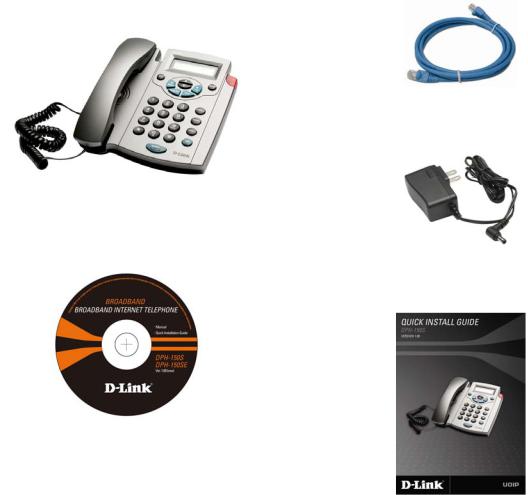
Introduction
VoIP (Voice over Internet Protocol; also known as Internet Phone) is a technology that allows anyone to make a telephone call over the Internet environment. This is an operation manual for the DPH-150S IP Phone. It is intended to help you configure the telephone. Please follow the user guide carefully as troubleshooting the telephone can be very difficult and time consuming.
1. Getting Started 1.1. Package Contents
The following materials are included in the package. Please check the package to ensure that all the materials are present, as listed below. Contact your supplier immediately if any item is missing.
Ethernet Cable (1.5 meter)
DPH-150S VoIP Phone
Power Adapter (DC 5V)
CD for User Manual
Quick Installation Guide
4

1.2. Phone Specifications
Protocol |
Pre-dial before sending |
NAT Traversal |
|
IETF SIP (RFC3261) |
Hot Line |
UPnP |
|
Network Interface |
Handset / Speakerphone |
STUN |
|
Volume adjustment |
Static port mapping |
||
RJ45 x 2, 10/100BaseT |
Speed dial (10 records) |
TCP/IP |
|
LCD Display |
Phone book (200 records) |
||
Call history (Incoming calls / |
IP/TCP/UDP/DHCP/RTP/ |
||
2 x 16 characters |
Outgoing calls / Missed |
FTP//HTTP/NTP/TFTP/DNS |
|
Key Pad |
calls) |
Configuration |
|
MP3 Ringer |
|||
25 keys |
Internet Radio |
Key & LCD configuration |
|
Call Features |
Security |
Web browser configuration |
|
Auto/Manual provisioning |
|||
Call Hold / Resume |
HTTP 1.1 basic/digest |
system |
|
Call Mute |
authentication for Web setup |
(Support TFTP/HTTP/FTP) |
|
Call Transfer (Unattended / |
MD5 for SIP authentication |
Firmware Upgrade |
|
Blind & Attended) |
(RFC 2069/ RFC 2617) |
||
Call Waiting |
Dial Methods |
TFTP |
|
Call Forward (Busy / |
Auto/Manual provisioning |
||
No Answer / Unconditional) |
Direct IP call without SIP |
system |
|
Caller ID Display |
registration |
(Support TFTP/HTTP/FTP) |
|
Anonymous Call |
Dial number via SIP server |
Power |
|
Anonymous Call Blocking |
Dial URI from phone book / |
||
In band DTMF / Out-of-band |
speed dial |
Input AC 100-120V / |
|
DTMF (RFC 2833) / |
Voice Quality |
220-240V |
|
SIP INFO |
Output DC 5V |
||
3-way Conference |
VAD (Voice Activity |
Environmental |
|
Redial |
Detection) |
||
Message Waiting Indicator |
CNG (Comfort Noise |
Operating temperature: 0 |
|
(RFC3842) |
Generation) |
40 |
|
SMS (RFC 3428) |
AEC (Acoustic Echo |
Storage temperature: -20 |
|
Auto Answer (Support SIP |
Cancellation) |
60 |
|
server required) |
G.168 |
Operating humidity: 20% |
|
Codec |
Jitter buffer |
80% |
|
QoS |
Physical Dimensions |
||
G.711µ-law |
|||
G.711a-law |
ToS field |
Size: 196(L) x 198(W) mm |
|
G.729a/b |
IEEE 802.1Q VLAN |
Wall Mount |
|
Phone Functions |
Tone |
Weight: 760g |
|
Color: Dark Gray |
|||
Multi-user (4 SIP accounts) |
DTMF |
Certification Compliance |
|
Speakerphone |
Ring Tone, 8 selectable |
||
communication |
tones |
FCC Part 15 Class B |
|
Pre-dial before sending |
Ring Back Tone |
CE Class B |
|
Hot Line |
(local and remote) |
VCCI Class B |
|
Handset / Speakerphone |
Dial Tone |
EN60950 |
|
Volume adjustment |
Busy Tone |
|
5
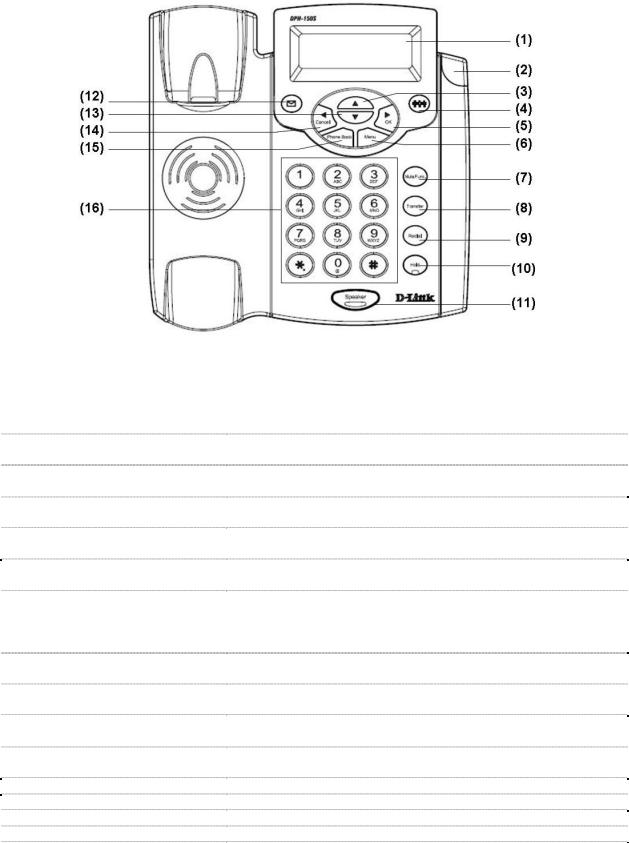
1.3. Phone Diagram
No. |
Key |
Function |
|
(1) |
2 x 16 Characters LCD |
Displays menu, time, clock, name, phone number, call status |
|
Display |
|
||
|
Indicates that phone is currently in use or ringing |
||
(2) |
LED Indicator |
||
|
|||
(3) |
Up |
Cycle through the phone menu, adjust volume |
|
|
|||
(4) |
3-Way Conference |
Enable 3-way conference |
|
|
|||
(5) |
OK / Right |
Confirm setting change, exit menu, dial, save changes |
|
|
|||
(6) |
Menu |
Access the phone menu |
|
|
|||
|
|
Disable user’s microphone so that the person on the other line |
|
|
|
||
(7) |
Mute/Function |
can not hear anything, access the language selection, access the |
|
time format |
|||
|
|
||
(8) |
Transfer |
Transfer the person you are currently having a conversation with |
|
to another line |
|||
|
|
||
(9) |
Redial/Call History |
Redial last dialed number, access redial menu |
|
|
|||
(10) |
Hold |
Place the person on the other line on hold, answer call waiting |
|
|
|||
(11) |
Speaker Phone |
Enable user to use the phone without using the handset |
|
|
|||
(12) |
Voice Message |
Check for voice messages |
|
(13) |
Down |
Cycle through the phone menu, adjust volume |
|
(14) |
Cancel / Left |
Deny changes, cancel phone calls, ignore phone calls, backspace |
|
(15) |
Phone Book |
Access the phonebook |
|
(16) |
Numeric Keypad |
Input IP/phone number/alphabet character |
6
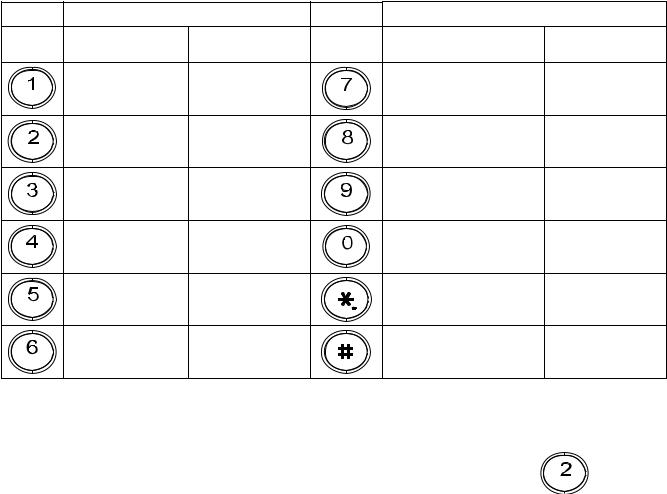
1.4. Key Pad Definition and Text Entry
You can use alphanumeric characters to enter details into the phone, including the phone book and other settings. The table below shows the characters that you can enter in the different text modes.
|
Text Mode |
|
Text Mode |
||
Key |
Normal (ABC) |
Numeric (0-9) |
Key |
Normal (ABC) |
Numeric (0-9) |
|
|
1 |
PQRS |
pqrsPQRS |
7 |
ABC |
abcABC |
2 |
TUV |
tuvTUV |
8 |
DEF |
defDEF |
3 |
WXYZ |
wxyzWXYZ |
9 |
|
ghiGHI |
4 |
|
. |
0 |
GHI |
@ |
, |
|||
|
|
|
|
|
|
JKL |
jklJKL |
5 |
|
. |
* |
MNO |
mnoMNO |
6 |
|
|
# |
In Normal and Numeric modes, each time you quickly the same key, the next character available on that key will be displayed. When you did not press key for more then 1 sec the current character will be selected and the
cursor will move right for the next selection. For example, to enter “c” you need to press |
ABC |
quickly four |
|
||
times. To enter the displayed character, release the key or press another key. |
|
|
7

2. Connecting the IP Phone
Connect the IP Phone as in the following diagram:
Wide Area Network / Internet
Cable/xDSL
Modem
Router/HUB/
Switch
Ethernet Cable
Ethernet Cable
Power Adapter
LAN |
WAN |
DC IN 5V |
8
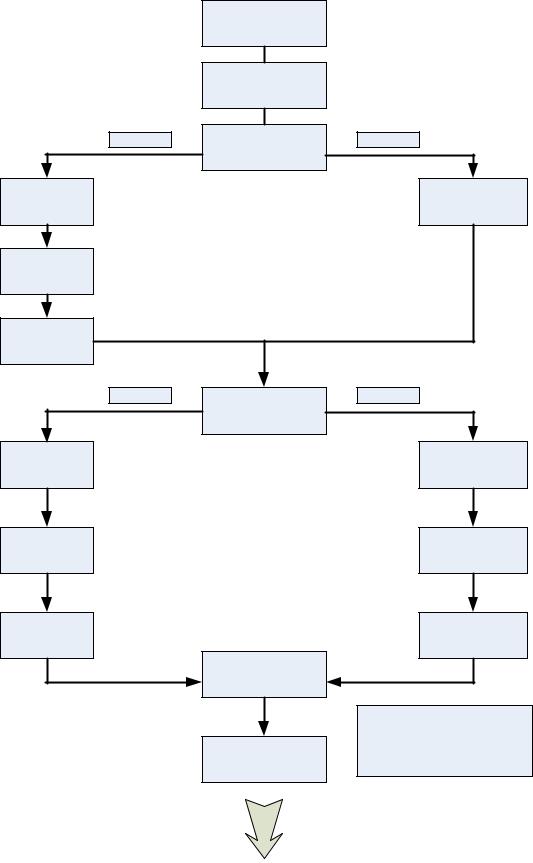
3. Initial Setup
3.1. IP Phone Setup Map
9

SNTP Cycle: 01
Do Not Disturb:
ENABLE/DISABLE
CF Unconditional:
ENABLE/DISABLE
CF User Busy:
ENABLE/DISABLE
CF No Answer:
ENABLE/DISABLE
Anonymous Call:
ENABLE/DISABLE
Anony Call Rej:
ENABLE/DISABLE
Ring Type:
Ringing1/2/3/4/5~8/9
WAN MAC Address: 00D0E9000001
LAN MAC Address: 00D0E9000002
Version:
V: 01.00
UPDATE CHANGES? <OK> OR <CANCEL>
1~4: Tone
5~8 : Melody
9: MP3
10
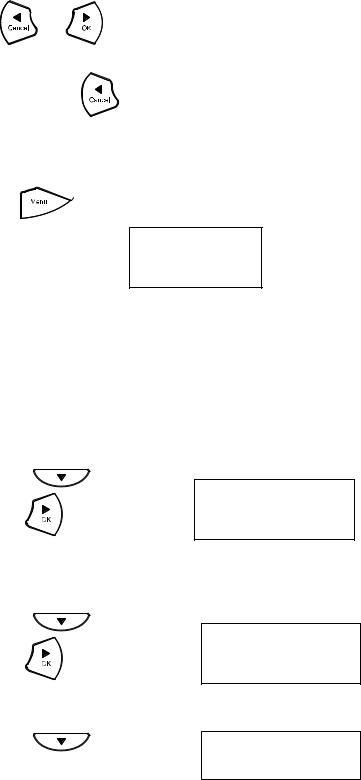
NOTE 1: If you made any modifications, you may quit setup at any time by pressing MENU + OK to save and exit or MENU + CANCEL to quit without saving. The phone will automatically exit from the menu screen if there are no inputs from the user.
NOTE 2: Use |
or |
to select ENABLE or DISABLE. |
NOTE 3: The left arrow key |
can be used as the Backspace key. |
3.2. Display Name
z |
Press |
|
z |
Enter the display name |
Display Name: |
|
|
|
|
|
Your name |
3.3. ADSL Dialup
Some Internet Service Providers (mostly ADSL) use PPPoE, which requires that the user enter an ID and a password to access the Internet. In this case, enable ADSL DIALUP and enter the PPPoE ID and PPPoE password.
3.3.1. Enable ADSL Dialup
z |
Press |
ADSL DIALUP: |
|
|
|
|
Use |
ENABLE |
z |
to select “Enable” |
3.3.2. Setup ADSL ID
z |
Press |
ADSL ID: |
|
|
|
|
Use |
MY_ADSL_ID |
z |
to select “Enable” |
3.3.3. Setup ADSL Password
z |
Press |
ADSL Password: |
z |
Enter ADSL Password |
******* |
|
|
11
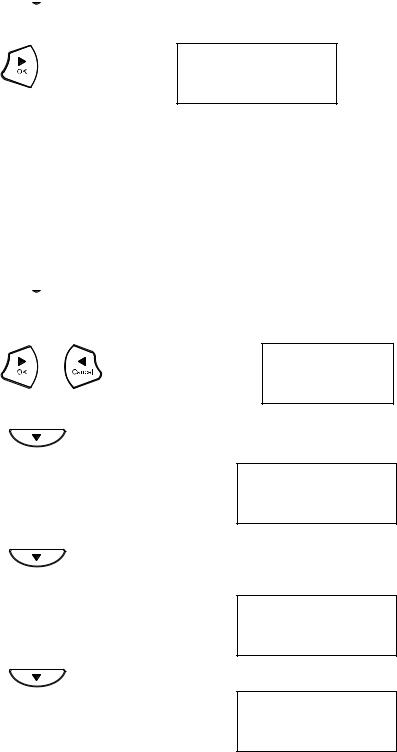
3.3.4. Disable ADSL Dialup
zPress 
ADSL DIALUP:
z Use |
to select “Disable” |
DISABLE |
3.4. DHCP (Dynamic Host Configuration Protocol)
DHCP allows the network administrator to distribute IP addresses when a computer is plugged into a different place in the network. If your ISP provides a static IP address, you must disable DHCP and enter the IP address provided.
3.4.1. Enable DHCP
zPress 
|
|
|
|
DHCP: |
|
|
z |
Use |
or |
to set DHCP “Enable” |
ENABLE |
|
|
z |
Press |
|
|
|
|
|
z |
IP address automatically acquired |
IP Address: |
|
|||
|
|
|
|
192.168.001.161 |
||
z |
Press |
|
|
|
|
|
z Subnet mask automatically acquired |
Subnet Mask: |
|
||||
|
|
|
|
|
||
|
|
|
|
255.255.255. |
0 |
|
z |
Press |
|
|
|
|
|
z Router IP automatically acquired |
Router IP: |
|
||||
192.168.001.161 |
||||||
|
|
|
|
|||
12

3.4.2. Disable DHCP
zPress 
z Use |
or |
to set DHCP “Disable” |
DHCP: |
|
|
|
DISABLE |
zPress 
z |
Enter the IP address |
IP Address: |
|
|
192.168.001.161 |
z |
Press |
|
z Enter the subnet mask |
Subnet Mask: |
|
|
|
|
|
|
255.255.255.000 |
z |
Press |
|
z |
Enter the router IP address |
Router IP: |
|
|
192.168.001.001 |
3.5. DNS Server IP
The domain name system (DNS) is the way that Internet domain names are located and translated into Internet Protocol addresses. There is probably a DNS server within close geographic proximity to your ISP that maps the domain names in your Internet requests or forwards them to other servers on the Internet.
z Press 
DNS Server IP:
192. 76.144. 66
3.6. SNTP Server IP
Simple Network Time Protocol (SNTP) is a protocol used to help match your system clock with an accurate time source. If you do not know your SNTP Server IP, please ignore this section. The SNTP Server IP address can be either URL or IP.
z |
Press |
|
z |
Enter SNTP server IP or URL |
SNTP Server IP: |
|
|
|
|
|
220.130.158.52 |
13
